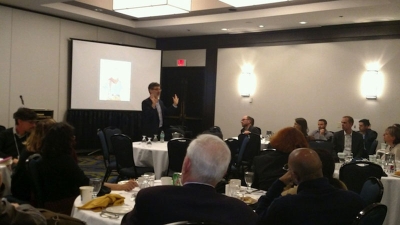Society for Novel Studies Tom McCarthy Keynote Recap

By: Nick Huber
Tom McCarthy delivered a keynote speech entitled “Vanity’s Residue” to the 2016 Society for Novel Studies Biennial Conference held in Pittsburgh, PA on May 13th and 14th. As the author of four novels including Remainder (2005) and Satin Island (2015), a work of criticism revolving around Herge’s Tintin comics (Tintin and the Secret of Literature), and dozens of essays on contemporary aesthetic problems, McCarthy offered a welcome repositioning of the conference’s viewpoint from the scholar of the novelist to the novelist himself.
And yet McCarthy proved to be as intellectually nimble and canny as readers of his novels might have expected. Proposing we understand the work of the novelist as a series of distress signals or, more emphatically, of pings from a black box unrecovered from terra incognita, from the gap between world and map, McCarthy followed the smoke trails from Clytemnestra to Trevor Paglen in a provocative demonstration of the ricochet from content to form and the point at which the latter becomes the former. The talk’s speculative thesis—that the novelist’s prerogative is to get lost—was a familiar trope but McCarthy built a de-narrativized conceptualization of writing, marking, and transmission that consistently valorized negativity as a powerfully generative force, thereby dissolving any rote New Age pseudo-bildungsroman of self-discovery that often accompanies such a position. The state of being lost, for McCarthy, is not existential so much as material: “how do you put the world on paper?” In a move characteristically erudite and puckish in equal measures, McCarthy deflected easy answers to this question by offering his own in the form of a quotation from an early 20th century geographer (J. A. Steers) that resists settling anything: “As it is impossible to make a sheet of paper rest smoothly on a sphere, so it is impossible to make a correct map on a sheet of paper.” The impossibility of definitively mapping what is perceived, let alone interpreting that map with final confidence, arises out of the materials themselves, McCarthy argued, in the spatial breach between the markings and their referents.
It is in these terms—and in following Agamben—that McCarthy suggested that Melville’s “Bartleby, in not writing, becomes the writer par excellence, embodiment of the Arabic Qualam or Pen, angel of unfathomable potentiality.” Or take his next example, Francis Ponge’s rumination on the capacities of the sponge (which comes to McCarthy via Derrida) which figures writing as “a messy, always incomplete engagement with material surplus, dirty spillage.” These models seem to describe McCarthy’s work as a novelist as well as his work in the International Necronautical Society. McCarthy shared a few examples of the work produced under this heading, including Greenwich Degree Zero, an historical rewriting and filmed reenactment of the 1894 failed bombing of the Greenwich Observatory as the successful 1894 bombing of the Greenwich Observatory. McCarthy, before fielding questions from the audience, traced outward from this reenactment using Michel de Certeau’s The Practice of Everyday Life to consider the figure of “someone—anyone—who is dying” and suggested in conclusion and in agreement with de Certeau that the “dying man who tries to speak” might be, precisely, the writer.
